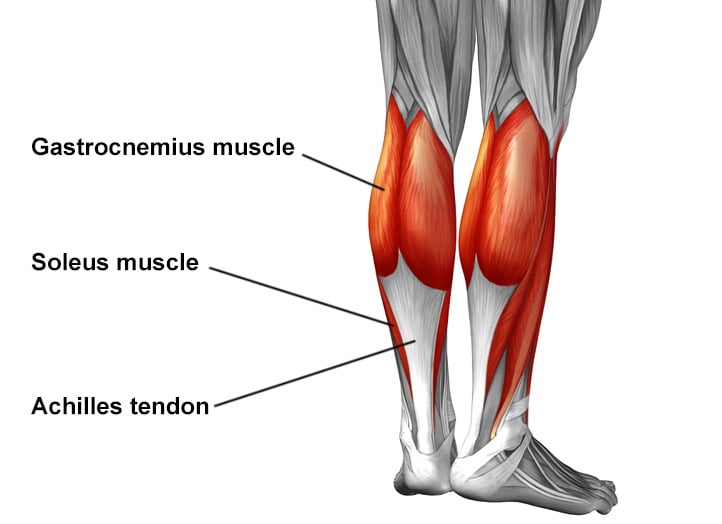Achilles Tendon Pain
Summary: The Achilles tendon is the strongest tendon in the body but is prone to overuse injuries such as tendinopathy, tendonitis, and rupture. Initial treatment is usually non-operative and includes physical therapy, activity modification, and strengthening. However, recovery may take 3 to 6 months or longer. Prevention of Achilles tendon injuries focuses on stretching, calf muscle strengthening, and gradual training progression.

On this page:
- Where is the Achilles tendon?
- Why do I have Achilles pain when walking?
- How do I know if my pain is serious?
- Should I stretch a sore Achilles?
- Should I stop exercising?
- How is Achilles tendon pain diagnosed?
- Achilles tendon pain causes and injury location
- How is Achilles tendon pain treated?
- What type of doctor treats it?
- What's the recovery time for an Achilles injury?
- What helps tendons heal faster?
- Achilles tendon injury prevention
- Key takeaways
Where is the Achilles tendon?
Achilles tendon anatomy
The Achilles tendon is a thick tendon located in the back of the lower leg. It connects the gastrocnemius and soleus muscles in the calf to an insertion point at the calcaneus (heel bone). It is the strongest tendon in the body and allows people to push off while walking, running, and jumping.

Why do I have Achilles tendon pain when walking?
While walking, the gastrocnemius and soleus muscles contract and pull on the Achilles tendon, which allows the foot to push off. This repetitive pulling on the Achilles tendon to propel the body forward may result in pain.
How do I know if my Achilles pain is serious?
If you hear a “pop” or have sudden and severe pain, especially while playing sports, this may be concerning for an Achilles tendon rupture. Additionally, persistent pain for several weeks or months that is limiting your activity level may be an indication to see a specialist.
Should I stretch a sore Achilles?
Gently stretching a sore Achilles tendon can help. Tight calf muscles (the gastrocnemius and soleus muscles) may lead to Achilles tendon pain. Stretching can help to reduce tension on the Achilles tendon. However, stretching a very sore Achilles tendon may result in exacerbation of the pain. Similarly, stretching an Achilles tendon that has ruptured may lead to the tendon edges being pulled farther apart.
Should I stop exercising if I have Achilles pain?
Certain sports, especially ones with explosive movements such as pickleball, tennis, and basketball, and activities that involve high-impact movement may lead to an Achilles tendon rupture or worsening of Achilles tendon pain in patients with pre-existing Achilles tendon pain. However, low impact activities such as cycling or swimming may allow you to maintain your fitness level without aggravating the tendon.
How is Achilles tendon pain diagnosed?
Achilles tendon pain is typically diagnosed using clinical examination, which means without radiographs or advanced imaging. X-rays may be taken, however, to look for bone spurs where the Achilles tendon inserts into the heel bone.
Achilles tendon pain causes and injury location
Achilles tendon pain typically occurs at two main locations. It may occur at the mid-substance of the Achilles tendon a few centimeters above where the Achilles tendon meets the bone (non-insertional Achilles tendinopathy). Alternatively, it can occur where the Achilles tendon inserts on the heel bone (insertional Achilles tendinopathy).
Achilles tendonitis
Achilles tendonitis, or acute inflammation of the Achilles tendon. This is less common than Achilles tendinopathy. It is primarily caused by high impact or explosive activities, such as frequent running, jumping, or changing direction.
Achilles tendinopathy or tendinosis
Achilles tendinosis is a chronic, degenerative condition of the tendon as opposed to Achilles tendonitis, which is an acute inflammation of the tendon. There is no inflammation associated with tendinosis, but rather disorganized and deteriorated tissue. This condition usually results from wear and tear over time.
Retrocalcaneal or Achilles tendon bursitis
Achilles tendon bursitis, more precisely referred to as retrocalcaneal bursitis, is inflammation of the retrocalcaneal bursa, a small cushioning sac that lies between the calcaneus (heel bone) and the Achilles tendon. This is often an overuse injury and common in athletes.
Achilles tendon rupture
A tear in the tendon, known as an Achilles tendon rupture is a serious, traumatic injury that is common among competitive athletes. They are usually caused by abrupt, intense physical activity. They typically occur during high-impact running, cutting, or jumping.
However, a tear can also take place during less strenuous activity like walking if a person has pre-existing Achilles tendinopathy.
How is Achilles tendon pain treated?
Insertional or non-insertional Achilles tendinopathy is usually initially treated non-operatively. Non-operative management may include a combination of an anti-inflammatory medication, physical therapy, and activity modification. In cases refractory to non-operative management, surgery may be indicated.
What type of doctor treats Achilles tendon pain?
Foot and ankle orthopedic surgeons or sports medicine physicians in combination with physical therapists frequently treat Achilles tendon pain. A primary care physician may also be able to manage early cases of Achilles tendon pain.
What is the recovery time for an Achilles tendon injury?
Recovery from Achilles tendinosis depends on the severity. Mild to moderate cases may resolve within 3 to 6 months with the appropriate treatment. Expect to do at least three months of physical therapy before seeing improvement. If surgery is indicated or if there is a rupture of the tendon, then recovery may take 9 to 12 months or longer.
What helps tendons heal faster?
Appropriate rehabilitation and physical therapy have the strongest evidence for improvements in symptoms following tendon injury. Additionally, activity modification with the appropriate load on the tendon may also accelerate recovery.
Can platelet-rich plasma (PRP) injections or extracorporeal shockwave therapy (ESWT) accelerate Achilles healing?
The evidence for PRP and ESWT to accelerate healing for the Achilles tendon is mixed. They may be indicated in chronic cases, but the data for PRP and ESWT is not strong.
Achilles tendon injury prevention
Since a lack of flexibility is a cause of injury, proper stretching of the lower leg as well as proper warming up and cooling down before and after activity are the most basic ways to prevent Achilles tendon strains or tears. Strengthening the calf muscles may reduce overload on the tendon. Finally, progressively increasing activity will help to avoid injury as well. Swimming and other low impact exercises are best, including bicycling, if that activity does not cause any pain (which would indicate a likelihood of reinjury).
Video: Rehabilitation for an Achilles tendon tear
Key takeaways
- The Achilles tendon connects the calf muscles to the heel. It assists with push off, which helps you walk, run, and jump. However, it can get injured from overuse.
- The most common problems are tendinopathy (wear and tear), tendonitis (inflammation), bursitis (irritation of a cushion near the tendon), and tendon tears (ruptures).
- The diagnosis of Achilles tendon pain is typically clinical through examination. Occasionally, X-rays or advanced imaging such as an MRI are obtained.
- Most patients get better with physical therapy and changes in activity level. Surgery is only indicated if non-operative treatments don’t work or if the tendon tears.
- You can help prevent injuries by stretching, strengthening your calf muscles, warming up before exercise, and slowly increasing your activity.
In the news
- The two scariest words in the NBA: Calf strain
- From Tatum to Haliburton, why are Achilles injuries surging in the NBA?
- NBA Star Jayson Tatum Reveals Agony of His Injury For First Time — And How Sons Deuce and Dylan 'Kept My Spirits Up'
- Pacers star Tyrese Haliburton has surgery on right Achilles tendon
- Stevens Gives Positive Perspective on Tatum’s Injury and Other Celtics Health Updates
- Tiger Woods has surgery for ruptured left Achilles
- The Maggie and Perloff Podcast with Dr. Rock Positano
- Achilles Tendon and Heel Pain: Causes and Treatment
- NBA Player James Wiseman Breaks Silence After Devastating Injury
- Jets Must Be Patient With Aaron Rodgers, but Can They?
- Doctor suggests Aaron Rodgers could return to Jets by Week 1 next season: 'Very doable'
- Pickleball injuries
- Aaron Rodgers’s Season Is Over. What About His Career?
- What is an Achilles tear and can Aaron Rodgers recover?
- Dr. Rock Positano on Aaron Rodgers Achilles injury
- Mid-Calf Nerve Block May Enable Early Rehabilitation After Foot and Ankle Surgery, Preventing Pain While Allowing Foot Movement
- Marathon Training With an Injury Comes With a Few Rules
- What Works Best for Ruptured Achilles Tendons?
- Seattle Storm's Breanna Stewart undergoes minor surgery on Achilles
- Try These 5 Calf Exercises to Help Prevent Injury
- Sore Achilles Tendon? Here’s How to Treat It
- Jocelyn Willoughby Injury Update
- How Kevin Durant Beat the Worst Injury in Basketball
- Dr. Mark Drakos leads Hospital for Special Surgery study on Achilles tendon repair
- HSS Awarded Grant for Trial of Blood Flow Restriction Therapy After Achilles Tendon Repair
Achilles Tendon Injuries Success Stories
Medically reviewed by Matthew S. Conti, MD
